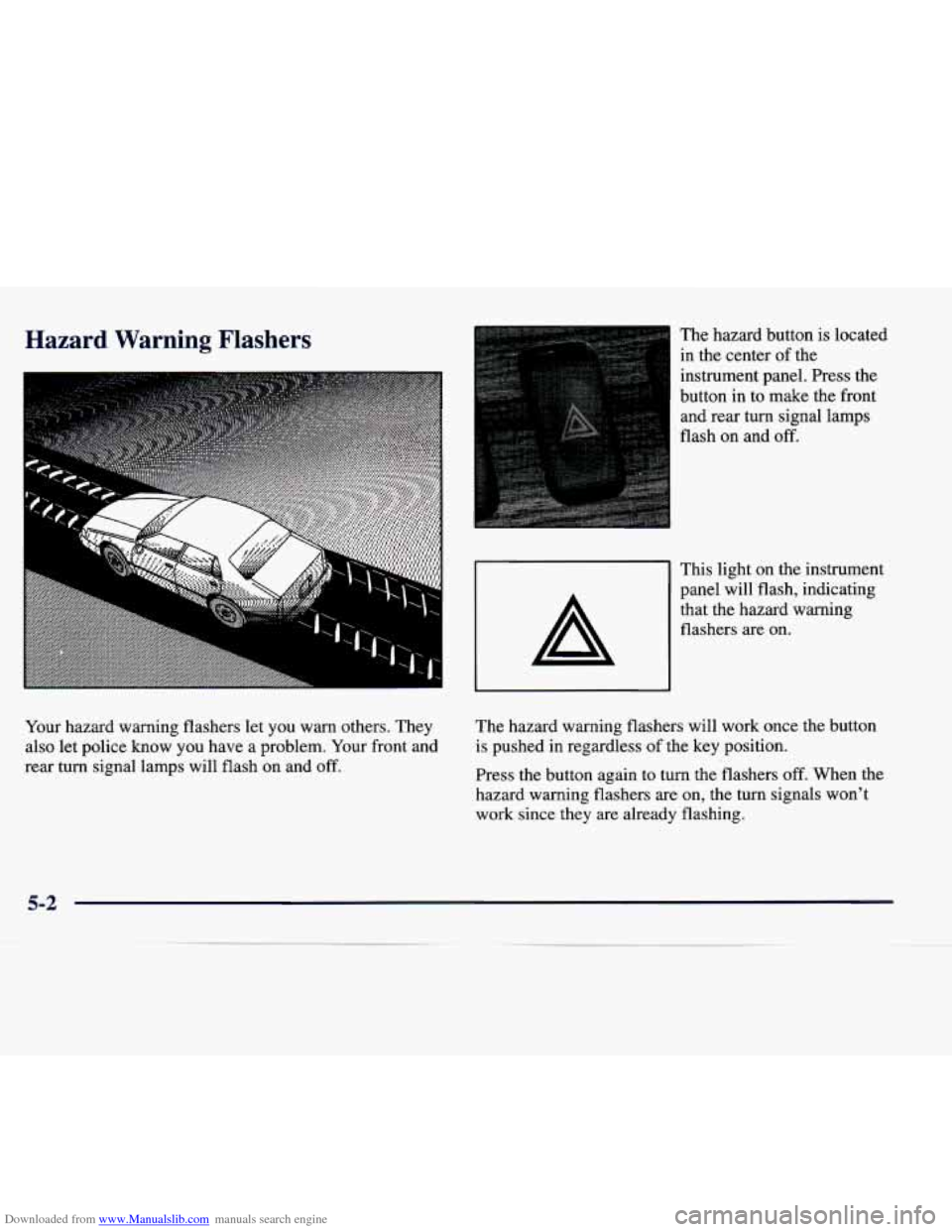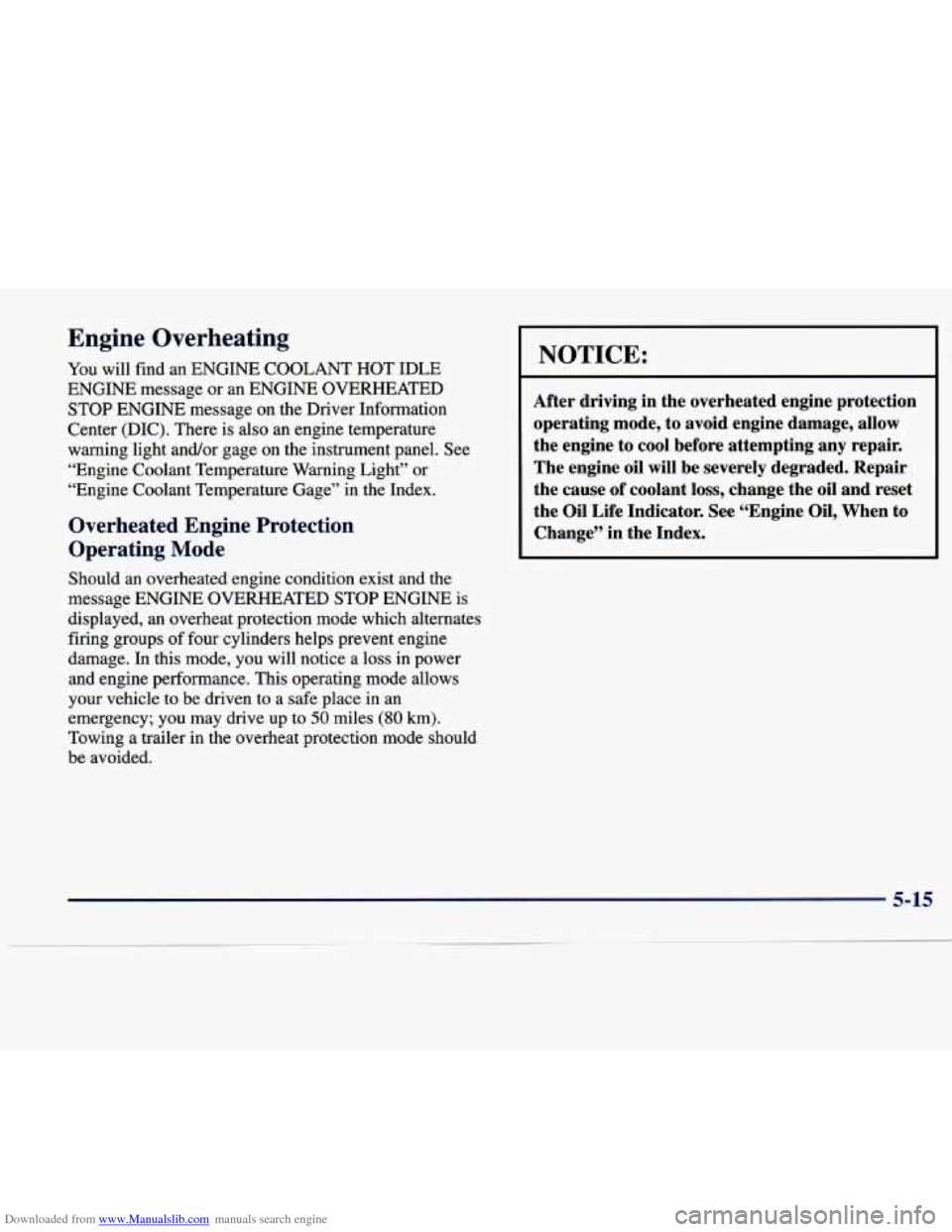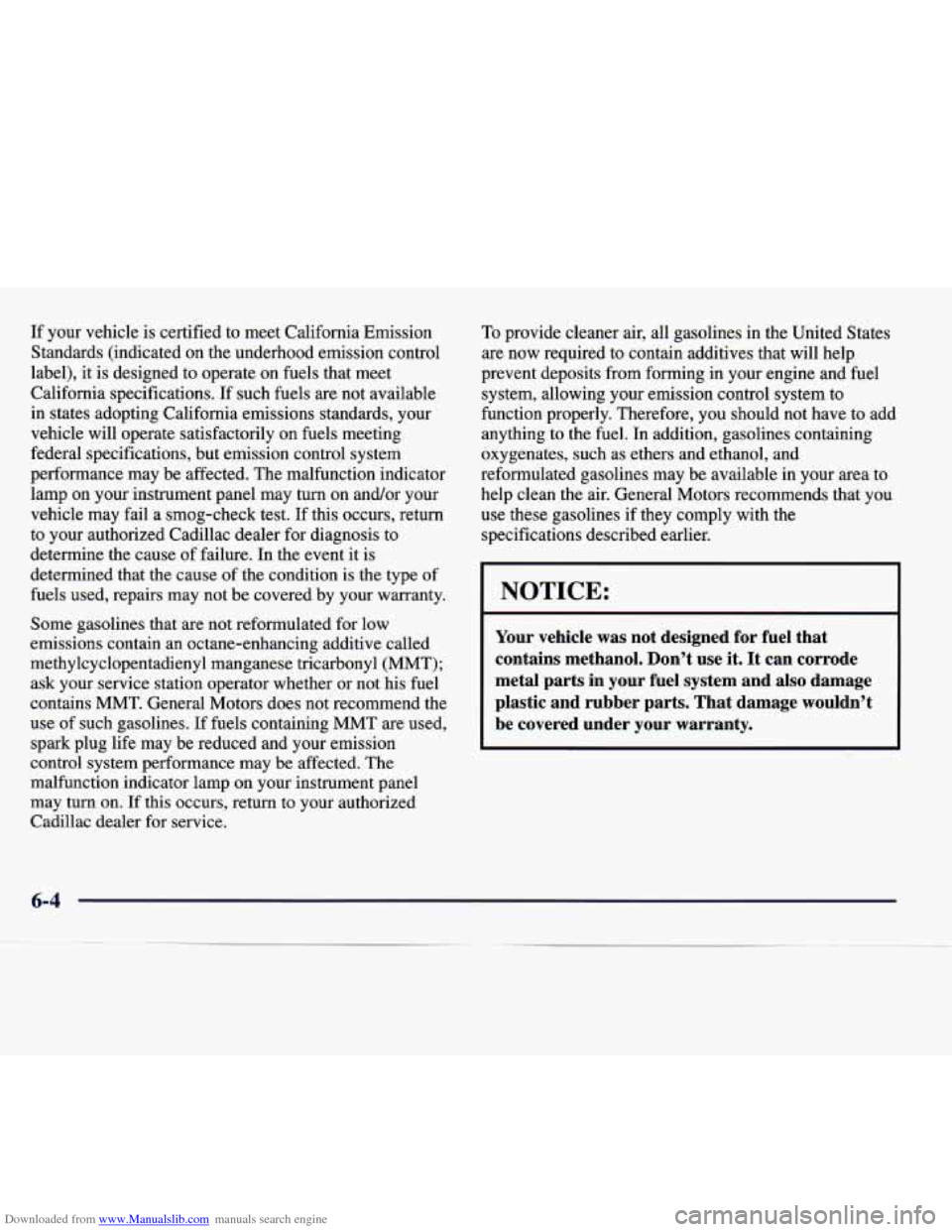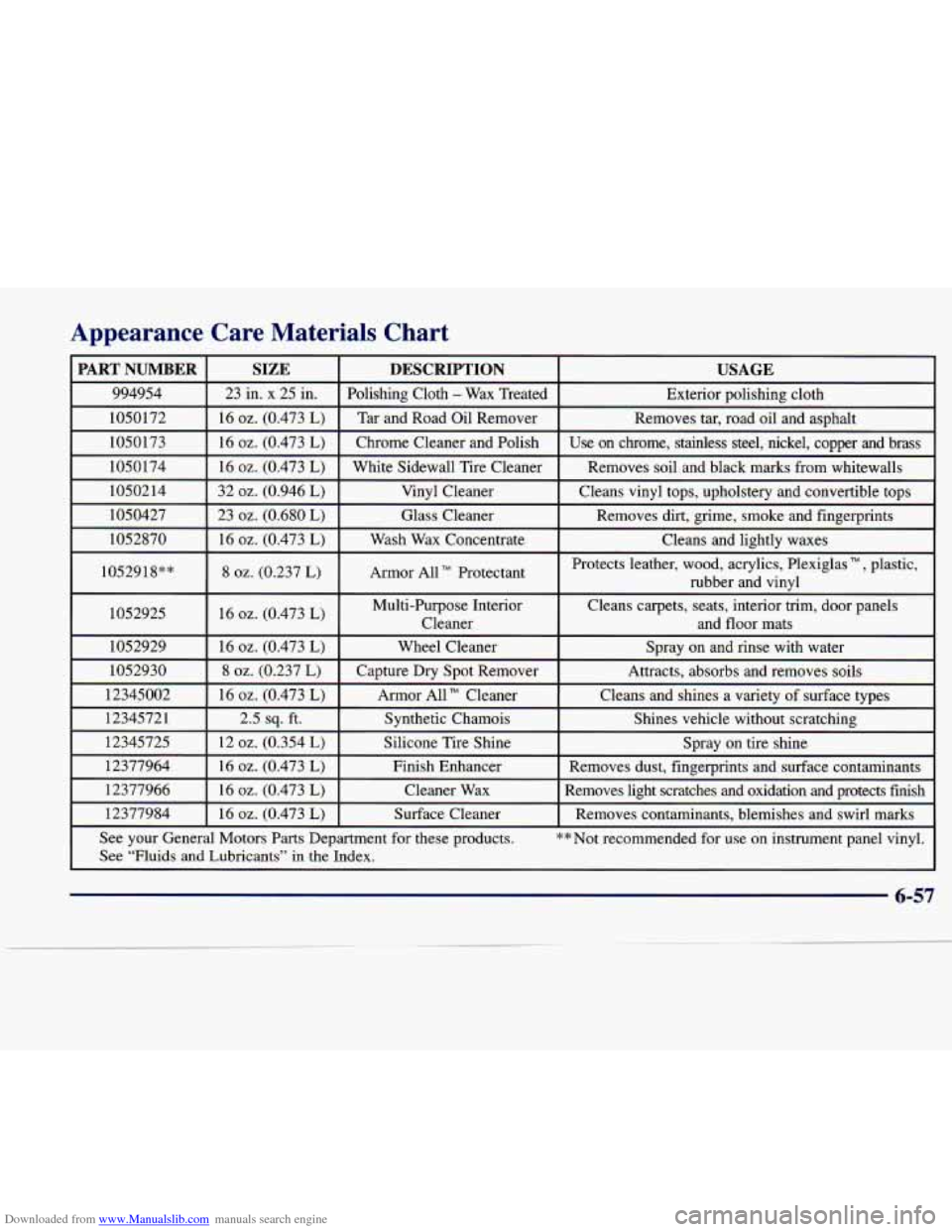1998 CADILLAC SEVILLE instrument panel
[x] Cancel search: instrument panelPage 234 of 378

Downloaded from www.Manualslib.com manuals search engine Turn Signals When Towing a Trailer
When you tow a trailer, your vehicle may need a
different turn signal flasher and/or extra wiring. Check
with your Cadillac dealer. The green arrows on your
instrument panel will flash whenever you signal a turn
or lane change. Properly hooked up, the trailer lamps
will also flash, telling other drivers you’re about to turn,
change lanes or stop.
When towing a trailer, the green arrows on your instrument panel will flash for turns even if the bulbs
on the trailer are burned out. Thus, you may think
drivers behind you are seeing your signal when they
are not. It’s important to check occasionally to be sure
the trailer bulbs are still working.
Driving On Grades
Reduce speed and shift to a lower gear before you start
down a long or steep downgrade. If you don’t shift
down, you might have to use your brakes
so much that
they would get hot and no longer work well.
On long uphill grades, reduce speed to 45 to 50 mph
(70 to 90 km/h) and avoid prolonged use of
SECOND (2) gear and engine speeds above 3800 rpm. Climbing grades steeper than 4 degrees at temperatures
above
90°F (32 “C)
with a loaded vehicle and trailer is
not recommended. The cooling system may temporarily
overheat. See “Engine Overheating” in the Index.
Parking on Hills
You really should not park your vehicle, with a trailer
attached, on a hill. If something goes wrong, your rig
could start to move. People can be injured, and both
your vehicle and the trailer can be damaged.
But if you ever have to park your rig on a hill, here’s
how to do it:
1. Apply your regular brakes, but do not shift into
PARK (P).
2. Have someone place chocks under the trailer wheels.
3. When the wheel chocks are in place, release the
regular brakes until the chocks absorb the load.
4. Reapply the regular brakes. Then shift into
PARK (P) firmly and apply your parking brake.
5. Release the regular brakes.
4-37
Page 239 of 378

Downloaded from www.Manualslib.com manuals search engine Hazard Warning Flashers
A
The hazard button is located
in the center
of the
instrument panel. Press the
button in to make the front
and rear turn signal lamps
flash on and
off.
This light on the instrument
panel will flash, indicating
that the hazard warning
flashers
are on.
Your hazard warning flashers let you warn others. They
also let police know you have a problem. Your front and
rear turn signal lamps will flash on and
off.
The hazard warning flashers will work once the button
is pushed in regardless
of the key position.
Press the button again to turn the flashers
off. When the
hazard warning flashers are on, the turn signals won’t
work since they are already flashing.
5-2
Page 252 of 378

Downloaded from www.Manualslib.com manuals search engine Engine Overheating
You will find an ENGINE COOLANT HOT IDLE
ENGINE message or an ENGINE OVERHEATED
STOP ENGINE message on the Driver Information
Center (DIC). There is also an engine temperature
warning light and/or gage on the instrument panel. See
“Engine Coolant Temperature Warning Light” or
“Engine Coolant Temperature Gage” in the Index.
Overheated Engine Protection
Operating Mode
NOTICE:
After driving in the overheated engine protection
operating mode, to avoid engine damage, allow
the engine to cool before attempting any repair.
The engine oil will be severely degraded. Repair
the cause
of coolant loss, change the oil and reset
the Oil Life Indicator. See “Engine Oil, When to
Change” in the Index.
Should an overheated engine condition exist and the
message ENGINE
OVERHEATED STOP ENGINE is
displayed, an overheat protection mode which alternates
firing groups
of four cylinders helps prevent engine
damage. In this mode, you will notice
a loss in power
and engine performance. This operating mode allows
your vehicle to be driven to
a safe place in an
emergency; you may drive up
to 50 miles (SO km).
Towing a trailer in
the overheat protection mode should
be avoided.
5-15
Page 279 of 378

Downloaded from www.Manualslib.com manuals search engine If your vehicle is certified to meet California Emission
Standards (indicated on the underhood emission control
label), it is designed to operate on fuels that meet
California specifications. If such fuels are not available
in states adopting California emissions standards, your
vehicle will operate satisfactorily on fuels meeting
federal specifications, but emission control system
performance may be affected. The malfunction indicator
lamp on your instrument panel may turn on and/or your
vehicle may fail
a smog-check test. If this occurs, return
to your authorized Cadillac dealer for diagnosis to
determine the cause of failure. In the event it is
determined that the cause of the condition is the type of
fuels used, repairs may not be covered by your warranty.
Some gasolines that are not reformulated for low
emissions contain an octane-enhancing additive called
methylcyclopentadienyl manganese tricarbonyl (MMT); ask your service station operator whether or not his fuel
contains MMT. General Motors does not recommend the
use of such gasolines. If fuels containing MMT are used,
spark plug life may be reduced and your emission
control system performance may be affected. The
malfunction indicator lamp on your instrument panel
may turn
on. If this occurs, return to your authorized
Cadillac dealer for service. To
provide cleaner air, all gasolines in the United States
are now required to contain additives that will help
prevent deposits from forming in your engine and fuel
system, allowing your emission control system to
function properly. Therefore, you should not have to add
anything to the fuel. In addition, gasolines containing
oxygenates, such as ethers and ethanol, and
reformulated gasolines may be available in your area to
help clean the air. General Motors recommends that you
use these gasolines if
they comply with the
specifications described earlier.
I NOTICE:
Your vehicle was not designed for fuel that
contains methanol. Don’t use it.
It can corrode
metal parts in your fuel system and also damage
plastic and rubber parts. That damage wouldn’t
be covered under your warranty.
6-4
Page 281 of 378

Downloaded from www.Manualslib.com manuals search engine To open the fuel door, push
the fuel release button
located below the light
controls under the instrument
panel on the left-hand side.
The vehicle must be in
PARK (P) or NEUTRAL (N)
and the valet lock switch
must be
off.
An alternate fuel door
release is located inside of
the
trunk on the left-hand
side. Pull it to release the
fuel door.
f
While refueling, hang the cap by the tether from the
hook on
the filler door.
To remove the cap, turn it slowly to the left
(counterclockwise). The cap has a spring in
it; if you let
go of the cap too soon, it will spring back to the right.
6-6
Page 284 of 378

Downloaded from www.Manualslib.com manuals search engine Hood Release
Pull the lever inside the
vehicle to open the hood. It
is located on the lower left
side of the instrument panel.
Then
go to the front of the vehicle and find the
secondary hood release which is located below the front
grille. Move the release lever to the left as
you raise
the hood.
6-9
Page 327 of 378

Downloaded from www.Manualslib.com manuals search engine Cleaning Vinyl
Use warm water and a clean cloth.
Rub with a clean, damp cloth to remove dirt. You
may have to do it more than once.
0 Things like tar, asphalt and shoe polish will stain if you
don’t get them
off quickly. Use a clean cloth and a
vinyvleather cleaner. See your dealer for
this product.
Cleaning Leather
Use a soft cloth with lukewarm water and a mild soap or
saddle soap and wipe dry with a soft cloth. Then, let the
leather dry naturally.
Do not use heat to dry.
For stubborn stains, use a leather cleaner. See your
0 Never use oils, varnishes, solvent-based or abrasive
dealer
for this product.
cleaners, furniture polish or shoe polish on leather.
0 Soiled or stained leather should be cleaned
immediately. If dirt is allowed to work into the
finish, it can harm the leather.
Cleaning the Top of the Instrument Panel
Use only mild soap and water to clean the top surfaces
of the instrument panel. Sprays containing silicones or
waxes may cause annoying reflections in the windshield
and even make it difficult to see through the windshield
under certain conditions.
Cleaning Interior Plastic Comr, --Its
Use only a mild soap and water solution on a soft
cloth or sponge. Commercial cleaners may affect the
surface finish.
Cleaning Wood Panels
Use a clean cloth moistened in warm, soapy water (use
mild dish washing soap).
Dry the wood immediately
with a clean cloth.
Cleaning Speaker Covers
Vacuum around a speaker cover gently, so that the
speaker won’t be damaged. Clean spots with just water
and mild soap.
6-52
Page 332 of 378

Downloaded from www.Manualslib.com manuals search engine Appearance Care Materials Chart
PART NUMBER USAGE
DESCRIPTION SIZE
994954
Exterior polishing cloth
Polishing Cloth - Wax Treated
23 in. x 25 in.
1050172 Removes tar, road oil and asphalt
Tar
and Road Oil Remover 16
oz. (0.473 L)
1050173
Cleans and lightly waxes
Wash Wax
Concentrate
16 oz. (0.473
L) 1052870 Removes dirt, grime, smoke
and fingerprints
Glass Cleaner 23
oz. (0.680 L) 1050427 Cleans
vinyl tops, upholstery and convertible tops Vinyl
Cleaner
32
oz. (0.946 L) 10502 14
Removes soil
and black marks from whitewalls
White Sidewall Tire Cleaner
16 oz. (0.473 L) 1050174 Use on chrome, stainless steel, nickel, copper
and brass
Chrome
Cleaner and Polish
16 oz. (0.473 L)
I 1052918"" I 8 oz. (0.237 L) I Armor
All" Protectant
1 1052925 I 16 02. (0.473 L) I
Multi-Purpose Interior
Cleaner
1052929
Synthetic Chamois
2.5
sq. ft. 12345721 Armor All
TM Cleaner
16 oz. (0.473 L) 12345002 Capture
Dry Spot Remover
8
oz. (0.237 L) 1052930 Wheel
Cleaner
16
oz. (0.473 L)
12345725
Surface Cleaner
16
oz. (0.473 L) 12377984 Cleaner
Wax
16
oz. (0.473 L) 12377966 Finish Enhancer
16
oz. (0.473 L) 12377964 Silicone
Tire Shine
12
oz. (0.354 L)
See your General Motors Parts Department
for these products.
See "Fluids and Lubricants" in the Index. Protects
leather, wood, acrylics, Plexiglas
TM , plastic,
rubber and vinyl
I
and floor mats
Cleans and shines a variety
of surface types
Shines vehicle without scratching
~ ~~
~
Spray on tire shine
Removes dust, fingerprints and surface contaminants
Removes light scratches and oxidation and protects finish
Removes contaminants, blemishes and swirl marks
k*Not recommended for use on instrument panel vinyl.
6-57